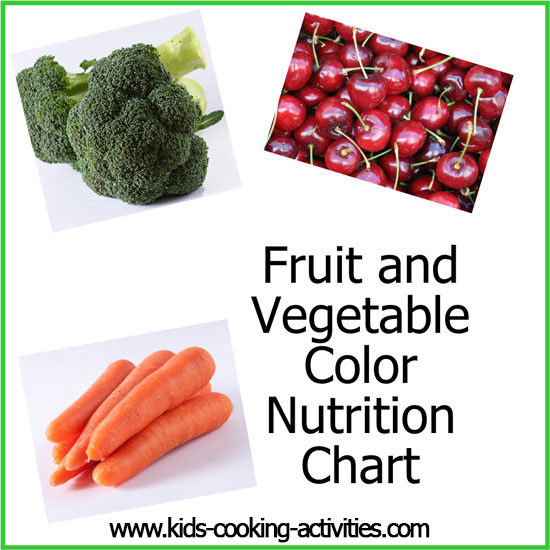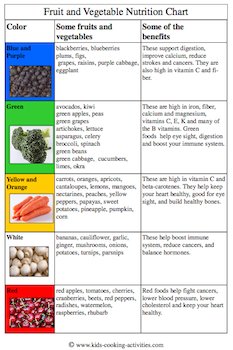Fruit and Vegetable Nutrition Chart
Check out our color fruit and vegetable nutrition chart. Not only is color more exciting, colors in vegetables and fruits are what gives us multivitamins, minerals and fiber our body needs so much. You should get at least 5 or more servings every day, so include many different colors of fruits and vegetables in your meals.
Serve a balance of different colored foods to your family. Seeing one color on their plates isn't as appealing as a variety of different colors and tastes. It is proven that a colorful meal will be more interesting and be eaten more then a meal all the same color. Imagine a plate with a cooked chicken breast, cooked rice and sliced bananas. They may be healthy but by adding a green salad and red strawberries or watermelon you are adding more nutrition and more color to your plate.
Kids Cooking Activities Teaching Materials
Make teaching easier with our activities and recipes compiled in theme sets and books with an easy to read formatPerfect for teaching!

~This post may contain affiliate links and I'll earn a small commission if you shop through them. There is no extra cost to you. This is how we help support our family and continue to bring you amazing content. To learn more see the affiliates disclosure here.~
Nutrition Food Chart
You can also print off a copy of this nutrition food chart to hang in your kitchen or use as a nutrition kids cooking lesson. You will need Adobe Reader to open and read the nutrition and color chart document.| Color | Some fruits and vegetables | Some of the benefits |
| Blue and Purple | blackberries,
blueberries plums, figs, grapes, raisins, purple cabbage, eggplant |
These support digestion, improve calcium, reduce strokes and cancers. They are also high in vitamin C and fiber. |
| Green | avocados, kiwi green apples, peas green grapes artichokes, lettuce asparagus, celery broccoli, spinach green beans green cabbage, cucumbers, limes, okra |
These are high in iron, fiber, calcium and magnesium, vitamins C, E, K and many of the B vitamins. Green foods help eye sight, digestion and boost your immune system. |
| Yellow and Orange | carrots, oranges, apricots, cantaloupes, lemons, mangoes, nectarines, peaches, yellow peppers, papayas, sweet potatoes, pineapple, pumpkin, corn | These are high in vitamin C and beta-carotenes. They help keep your heart healthy, good for eye sight, and build healthy bones. |
| White | bananas, cauliflower, garlic, ginger, mushrooms, onions, potatoes, turnips, parsnips | These help boost immune system, reduce cancers, and balance hormones. |
| Red | red apples, tomatoes, cherries, cranberries, beets, red peppers, radishes, watermelon, raspberries, rhubarb | Red foods help fight cancers, lower blood pressure, lower cholesterol and keep your heart healthy. |
You can learn more fruit and vegetable food facts, to go along with this fruit and vegetable nutrition chart and teach kids about healthy eating, on our kids-cooking-activities.com site under food facts.
Follow Kids Cooking Activities








